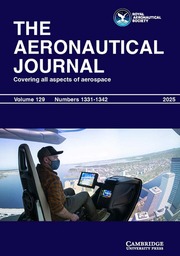Article contents
Improvements in the performance of a threeelement high lift system by the application ofairjet vortex generators
Published online by Cambridge University Press: 04 July 2016
Summary
Windtunnel tests on a two-dimensional model of a threeelement high lift system in a takeoff mode indicatethat airjet vortex generators can produce asignificant increase in lift at a given angle ofincidence and a substantial increase inCLmax. An associatedreduction in profile drag is inferred frommeasurements of momentum defect on the uppersurface.
The improvements are much greater than those typicallyachieved with vane vortex generators and cannotsimply be associated with the suppression ofboundary layer separation. Instead, the airjets andthe vortices which they generate promote enhancedmixing and momentum transfer across the complexshear layers above the main wing, from the externalflow right through to the surface. Detailed surveysreveal, for example, that the slat wake is dispersed— or absorbed into a region of greater shear — andthat the growth of the main wing boundary layer issignificantly reduced.
It is suggested that neither the relatively lowReynolds numbers . and Mach numbers of the tests,nor the effects of windtunnel interference, detractfrom the general relevance of the novel principleinvolved. Attention is drawn, however, to the needfor further work to elucidate and quantify the flowmechanisms and to establish the balance between thebenefits from the improved aerodynamics and theperformance costs of installing and supplying thejets.
Information
- Type
- Research Article
- Information
- Copyright
- Copyright © Royal Aeronautical Society 1995
References
- 12
- Cited by

